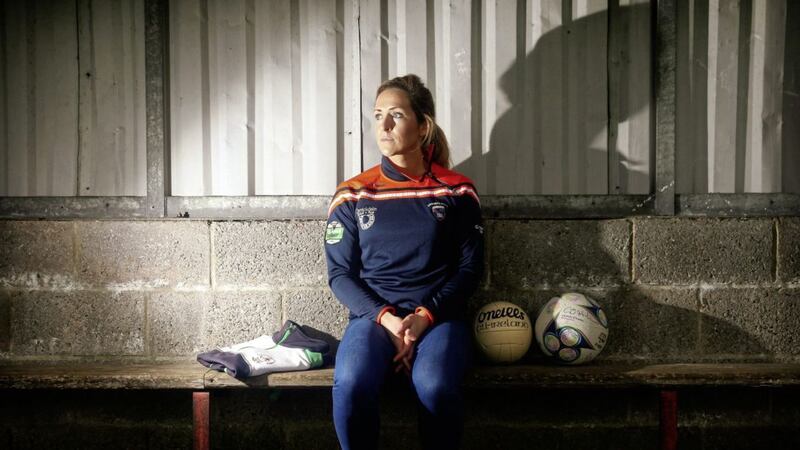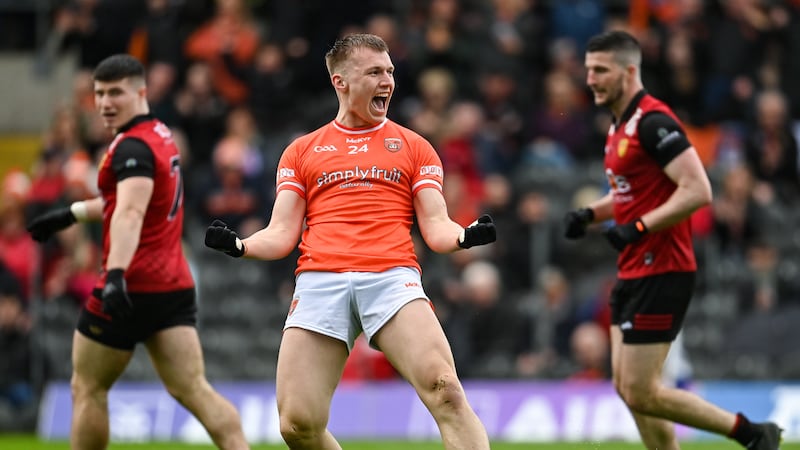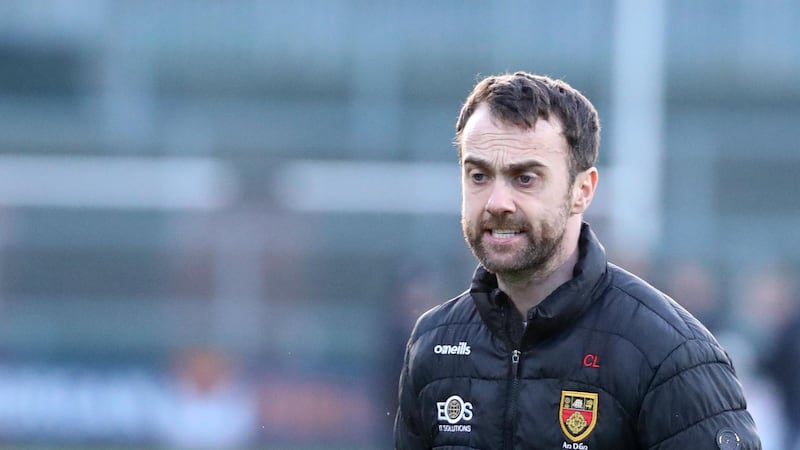FOR three hours, Caroline O’Hanlon sits in the corner of Art Bar Funkel in the heart of Newry. Facing through the window, she chats openly as the place picks up and then dies down around her.
Netball. Football. Life. School. Stigmas. Farming. Brexit. Medicine. Perceptions. Man United. Funding. The future. The end.
There is still no end in sight for the Carrickcruppen clubwoman, who turned 34 in August. When we meet, she is wavering. Several of her longest-serving colleagues have stepped away from Armagh and O’Hanlon is considering making the same decision.
After 17 years, she owed them nothing. But after a subsequent meeting with managers Fionnuala McAtamney and Lorraine McCaffrey, she’s back on board again.
“You have to gauge it on whether you think you’re still competitive, whether you can compete with the people around you,” she says.
“That’s where I judge things in training. Are you still at the front or where are you in relation to the pack? That, for me, is a good gauge of where things are at.”
Her prominence in the world depends on your own mind. Some would recognise her first as Northern Ireland’s netball captain, a Super League star with Manchester Thunder who occasionally pops up live on Sky Sports.
Most of her own constituents in south Armagh would see her as the former Ladies Footballer of the Year and long-serving Armagh captain.
Her interests in both started early. Her mother Marion and sister Joanne had both attended Our Lady’s Grammar School in Newry.
But having won player of the tournament at a primary school netball tournament held at Sacred Heart, they wooed her and she happily took their hand.
“I would have been conscious of wanting to be a vet, and I thought I had to go to the grammar school. But 100 per cent, I only went because they played netball and Our Lady’s didn’t.”
The vet thing. Her father, Charlie – a three-time Armagh SFC winner with Carrickcruppen - is a semi-retired cattle farmer and while she wasn’t exactly racing off the school bus to pull on the wellies, it always entertained her keen mind.
That became studying the sciences at A-Level and ultimately it morphed into medical studies of the human kind at Queen’s. She is currently working a three-day week as a GP in Dundrum.
Her time-management talents are well known - travelling to the north of England to play for Manchester Thunder in the Super League, playing with Northern Ireland around the world and Larkfield at home. Alongside her GAA commitments with Armagh and Carrickcruppen, it’s not what you’d call a quiet life.
“It’d be different if you had to work two jobs and you really hated it – to me, that’s busy, that’s stressful.”
At Queen’s, she played a bit of soccer. That led to an approach by Northern Ireland manager Alfie Wylie, but her plate was already stuffed.
As recently as a few months ago, she was approached about following her Irish International Rules team-mate Cora Staunton into the AFL.
“It came up. It just didn’t work out. There were discussions, it got beyond a couple of initial talks and I explored it a bit, but it just wasn’t going to be feasible.”
She’s managed to turn almost two decades out of being competitive at the top level, yet the crevices through which Caroline O’Hanlon could have fallen are not so much cracks in women’s sport as gaping chasms.
Her elder sister Joanne was simply never exposed to the same opportunities, and so never developed the same interest.
Caroline was drawn in to games with the older girls at St Joseph’s PS in Bessbrook while she hung about waiting for her mother’s working day to end.
When the boys were playing football at break-time and dinner-time, she’d hold her own. She didn’t care that she was the only girl.
“I still wasn’t as strong as them, so if they’re putting in a shoulder you might have been a bit sore but you weren’t allowed to show it because then you would have been ‘the girl’.
“If you stung your hand, you didn’t want to cry, that would be the end of your street cred,” she laughs.
“At the time I think you just wanted to play a game, same as you’d go outside, ‘will we play a match?’ and you just played it. It wasn’t to say I was thinking I was pioneering. I just wanted to play a game. I wasn’t bothered if other girls played or didn’t play.”
She came through just at a time when girls teams were starting to spring up around the place.
That was almost two decades ago but despite the rising profile of women’s sport, and the body of evidence that shows the positive impact of exercise, there are more and more cutbacks happening in schools.
Through her working life, she sees dwindling resources and interest being applied through by those in charge of the education system.
“Schools have a massive responsibility to offer alternatives, not just for the sake of sport but for the sake of wellbeing.
“It’s sad that it seems to be going in the opposite way again at the minute. The focus is more on league tables and results.
“Are you churning out people who are able to cope with the day-to-day pressures? It’s sad that schools are focussing that way. There are cuts again and the GAA one is massive.
“It’s not just because it’s GAA, but because that might be the only sport that’s in a lot of those schools and they’re taking it away.
“There needs to be a bigger focus, because the pressures we’re seeing in people, that I’m seeing day-to-day, we do need to do more to have better rounded people with a better balance. I don’t think taking sport out of schools is promoting that.”
*****
“I'd rather seen you carry a dead animal impaled on a stick than the sectarian Ulster banner. Not even a real flag. Just a symbol of hatred that turns nationalist stomachs…”
@lawnseed1 on Twitter
AMID the wave of congratulations that met the announcement that Caroline O’Hanlon would carry the flag for Northern Ireland at last year’s Commonwealth Games, there was the odd inevitable barb.
It had crossed her mind. Although briefly, how could it not? A nationalist girl from the fork in the road right between Camlough and Bessbrook, slap bang in the heart of south Armagh.
It was an area hit exceptionally hard by the troubles, where men from both sides lost their lives and where the British Army made the local linen mill into a major military base from which British Army helicopters would take off and land every few minutes as she grew up.
But sport and politics were never aligned in her mind. Firing had ceased by the time her sporting career was whirling its way skyward.
She’s been wearing the white and green of Northern Ireland for a decade-and-a-half now. Captained them. Been the sport’s public face.
The current Northern Ireland team is laced with cross-code GAA players. Last year, O’Hanlon was one of three inter-county captains that mixed Gaelic football with a big year at the Commonwealths.
Neamh Woods, who was outstanding as Tyrone won the All-Ireland intermediate title, and Down’s Laura Mason skippered their respective counties, while the likes of Dearbhla Coleman (Armagh) and Michelle Drayne (Antrim) also mix the two sports.
Declaring for Northern Ireland was made easy by the fact that the Republic had no team when she was coming up.
In the beginning, O’Hanlon admits being conscious of it, but the feeling quickly subsided.
It stayed away until she was told she’d been selected to lead the team out in the Carrara Stadium on the Gold Coast.
“Initially you didn’t hesitate because it’s a massive honour. But then you’re starting to think ‘aw, how’s this going to go down at home? This flag…’
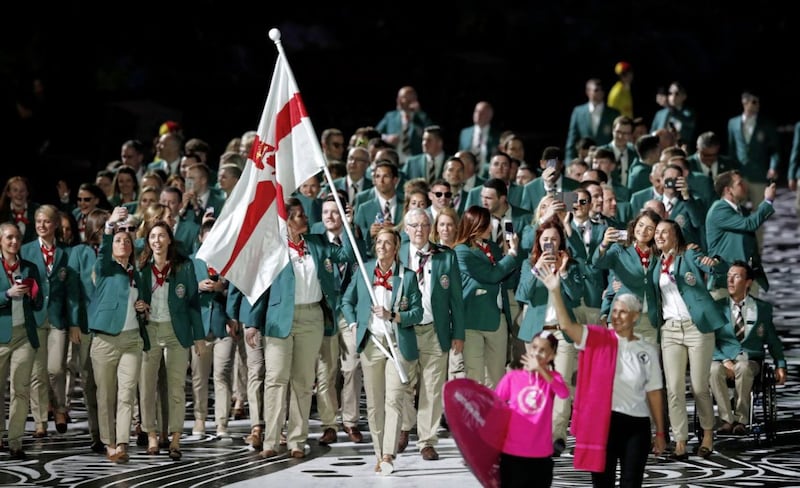
“But you take it on the positive of it what it was. I wanted netball to be at the front, what that represented for female sport and us as a team. The support was brilliant from everybody around. I had great support from the club [Carrickcruppen GAA].
“Obviously on Twitter you get a few random made-up accounts. It was very, very few.”
The positive sporting connotations far outweighed any misgivings.
Just four years on from their first ever appearance at a multi-sport event, it was hugely significant that netball was even considered for the honour. O’Hanlon’s role as captain made her the obvious choice from there.
So she had no hesitation in saying yes, and braced herself for come what may.
It never came. The reaction was one of universal congratulation.
“Honestly, you’re asked and it’s a huge honour, not just to carry the flag but what it represented.
“At the last Commonwealth Games, we were new. Netball had never been before, and they didn’t know much about it. So even the fact that they valued netball, and me as an athlete, enough to say ‘we want you to lead the team out’.
“It was a lovely experience and the likes of the boxers coming up and congratulating you, it’s nice for netball to be so central to the team.”
*****
O’HANLON was working as a radio analyst for RTÉ when the Ladies football finals attracted a record 46,000 attendance in 2017.
That looked as though it would be hard to surpass. It had grown annually and in just four years, had grown from 27,374 in 2014 to 46,286.
Yet 12 months later, she was back in the press box as the sport smashed another ceiling, drawing a crowd of 50,141.
Her own bittersweet All-Ireland experience, when they were bitterly beaten by a point by Cork in 2006, was played out in front of 25,665 people.
It seemed to have stagnated but the visibility offered by TG4 and the money and marketing savvy of Lidl watered the seeds for a growth spurt.
Yet the reality is that widespread media exposure is still largely dependent on negativity.
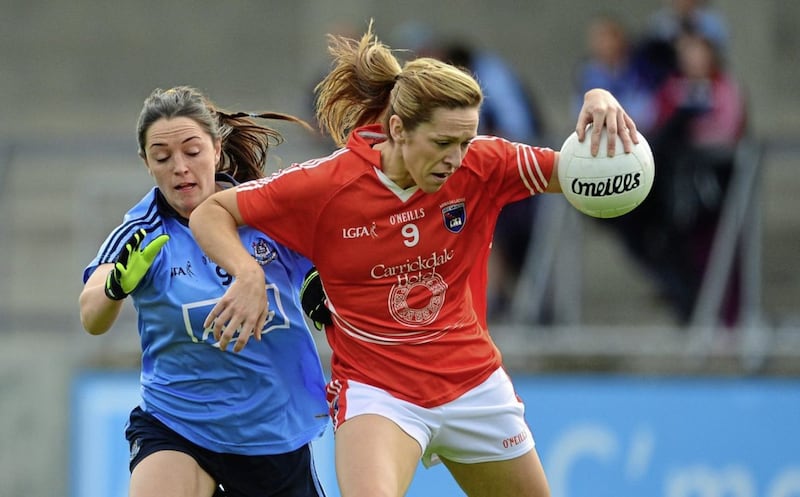
No better example than last summer’s row down in Mayo that made the back page of national newspapers. It saw eight members of the Carnacon club withdraw from the Mayo panel, and led to public claim and counter-claim between the players, manager Peter Leahy and the Mayo LGFA.
But while it brought chaos on the county and didn’t paint anyone involved in any great light, it had people talking.
In the weeks after Dublin had held off Cork again to retain the All-Ireland title, ladies’ football was dominating the airwaves.
It might not have been for the reasons they’d have liked, but the only thing worse than being talked about is not being talked about.
The sports themselves – football, camogie, the Irish women’s rugby team, netball itself – have found a footing in the public imagination. But a huge part of their success has been in the increase of critical analysis, a lot of it self-analysis.
On the morning of our interview, camogie was making headlines after Cork’s Amy O’Connor claimed Kilkenny’s policy of playing a seventh defender wasn’t good for helping to grow the sport.
“It’s getting there, we’re getting more of that,” says O’Hanlon of female sport in general.
“Teams are doing analysis and being critical of themselves, so it’s going to be a natural progression as the game tries to develop further.
“Even in terms of the athleticism of players, it’s massively developed. Strength and conditioning has gone up a level.
“You can see it comparable with netball, because there you’re competing with people who are professional athletes.
“There’s a lot of variation across the country because of resources but there’s been great strides made. The product’s better and that’s been a massive contributor as well, that people are interested.
“To play county football at that level for so long, you have to put up with a lot of shit.
“I don’t think inter-county men’s footballers would put up with it. They wouldn’t do it.”
There is still so much still to do.
A bit more consistency in terms of allowing physicality is the big in-game challenge.
In her extensive time, O’Hanlon has very seldom enjoyed the platform of a big day out in the Athletic Grounds with Armagh.
They still go around the clubs begging, or paying for council pitches to train and play on.
With plans, led by chairperson Sinead Reel, to spend over £100,000 on a new full-time LGFA training base in Killean, Armagh are ahead of the curve.
There’s no point moping. Small but significant moves such as the double-headers we’ll see in Pairc Úi Chaoimh during the National Leagues are strengthening the sport, brick by brick.
The players know what they’re taking into when they sign up.
And it’s far from an exclusive LGFA problem. They’re one of the more progressive bodies.
Consider the piece of string that held netball up. They’d just been to the 2014 Commonwealths and done well, finishing seventh despite starting as the lowest-ranked team there.
But they’d missed out on World Cup qualification in a one-point loss to Scotland, the build-up to which was mired in farce.
It led to their funding being wiped out.
“No more money, the whole lot out the door. And you’re thinking ‘how did that happen? We did really well there’.”
By the time they were trying to qualify for this summer’s World Cup, it was literally win or bust.
The team, largely through their own fundraising initiatives, paid their own way to Australia last year.
Those are the top-end issues that affect trying to develop the bottom-end of female sport. O’Hanlon is an ambassador the new 20x20 campaign that aims to increase participation, awareness and media coverage of women’s sport by 20 per cent over the next two years.
Schoolgirls depend on having visible role models, but also the chance to play the games too.
“Social media’s played a big role. It’s become a massive platform over the last five years to promote the game freely. But TV gives you that coverage for people who aren’t actively seeking it, who’d incidentally watch it.
“You notice that a lot. I’d get a lot of people from here saying ‘aw I saw your match, I didn’t realise you were on TV’.
“Being visible on any platform helps, but that probably reaches the most people.”
Caroline O’Hanlon was lucky in one way, that Tom McGuinness brought her into the world of netball, that her father took her down to Carrickcruppen pitch, and that there were teams for her to play on.
She’s made the most of that luck. Hers has been a simply incredible sporting career.
And it’s not done yet.
